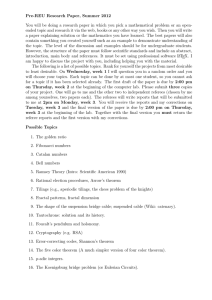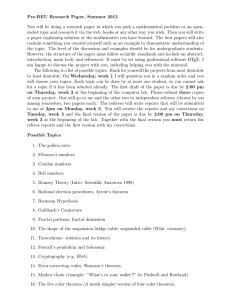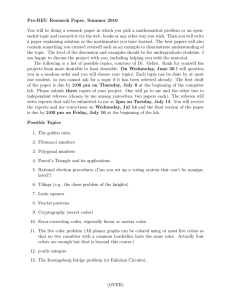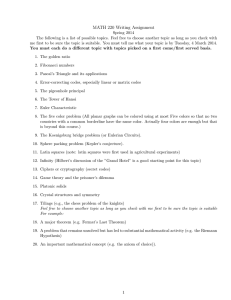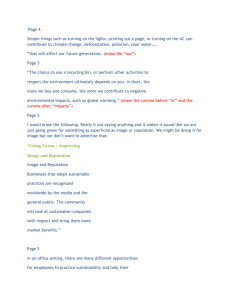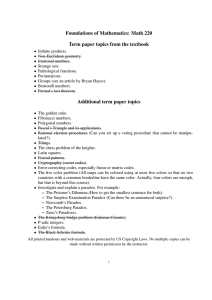Pre-REU Research Paper, Summer 2011
advertisement
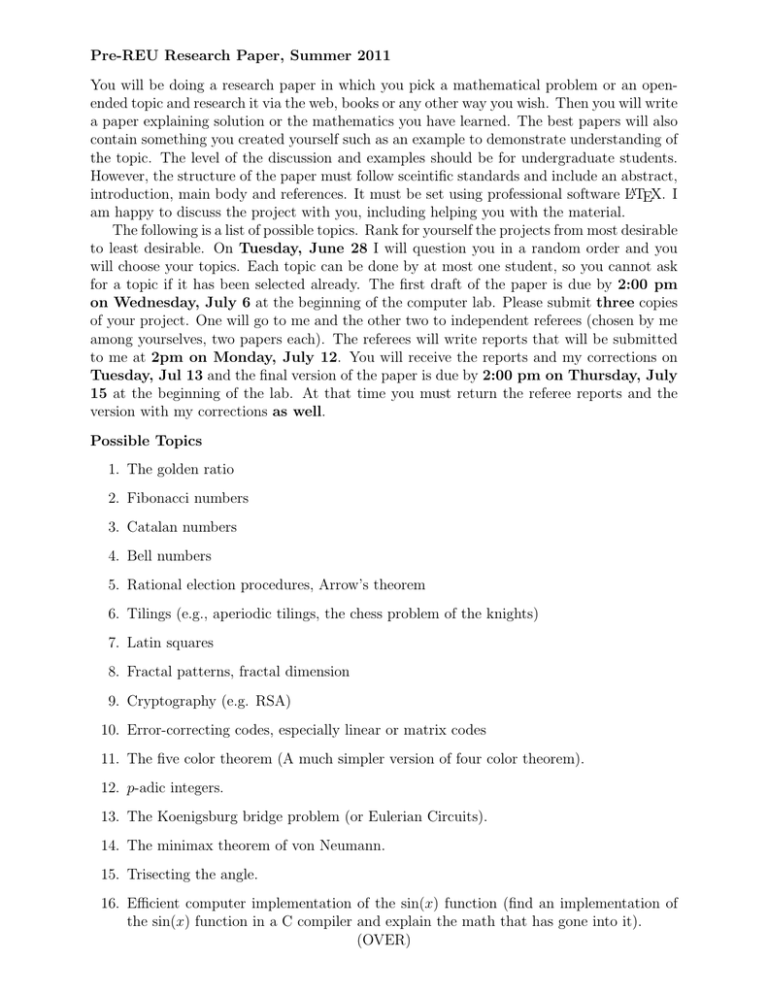
Pre-REU Research Paper, Summer 2011 You will be doing a research paper in which you pick a mathematical problem or an openended topic and research it via the web, books or any other way you wish. Then you will write a paper explaining solution or the mathematics you have learned. The best papers will also contain something you created yourself such as an example to demonstrate understanding of the topic. The level of the discussion and examples should be for undergraduate students. However, the structure of the paper must follow sceintific standards and include an abstract, introduction, main body and references. It must be set using professional software LATEX. I am happy to discuss the project with you, including helping you with the material. The following is a list of possible topics. Rank for yourself the projects from most desirable to least desirable. On Tuesday, June 28 I will question you in a random order and you will choose your topics. Each topic can be done by at most one student, so you cannot ask for a topic if it has been selected already. The first draft of the paper is due by 2:00 pm on Wednesday, July 6 at the beginning of the computer lab. Please submit three copies of your project. One will go to me and the other two to independent referees (chosen by me among yourselves, two papers each). The referees will write reports that will be submitted to me at 2pm on Monday, July 12. You will receive the reports and my corrections on Tuesday, Jul 13 and the final version of the paper is due by 2:00 pm on Thursday, July 15 at the beginning of the lab. At that time you must return the referee reports and the version with my corrections as well. Possible Topics 1. The golden ratio 2. Fibonacci numbers 3. Catalan numbers 4. Bell numbers 5. Rational election procedures, Arrow’s theorem 6. Tilings (e.g., aperiodic tilings, the chess problem of the knights) 7. Latin squares 8. Fractal patterns, fractal dimension 9. Cryptography (e.g. RSA) 10. Error-correcting codes, especially linear or matrix codes 11. The five color theorem (A much simpler version of four color theorem). 12. p-adic integers. 13. The Koenigsburg bridge problem (or Eulerian Circuits). 14. The minimax theorem of von Neumann. 15. Trisecting the angle. 16. Efficient computer implementation of the sin(x) function (find an implementation of the sin(x) function in a C compiler and explain the math that has gone into it). (OVER) 17. Investigate and explain one of the following paradoxes: (a) Newcomb’s Paradox (A variant of the Monte Hall problem) (b) The Exchange Paradox (c) Braess’s Paradox (d) Banach-Tarski Paradox 18. Solve one of the following problems: (a) Use the pigeonhole principle to prove that every rational number m/n has a decimal expansion that either terminates or repeats. In the case where a rational number has a repeating decimal expansion, find an upper bound (in terms of the denominator n) on the number of digits in the repeating part. (Hint: use long division, think about possible remainders; Wiki: pigeonhole principle). (b) Suppose you are given a sequence of numbers a1 , a2 , . . . , ak . Find a formula for a polynomial p(x) such that p(n) = an for all n = 1, 2, . . . , k. (c) Write the integers 1 to n clockwise on a circle. Starting from 1 repeat the following steps: keep one number, erase one number, going clockwise until only one number remains. What is the general formula (as a function of n) for the remaining number? Example (do it!): 1, 2, 3, 4, 5, 6, 7 on a circle. We keep 1, erase 2, keep 3, erase 4, keep 5, erase 6, keep 7, erase 1, keep 3, erase 5, keep 7, erase 3. The answer is 7. (d) You have 13 coins, one of which is fake: its weight is different, but you don’t know whether it’s lighter or heavier. You have balance scale that you can use to compare the weight of any two sets of coins. All coins must come from your set of 13 and you can not determine absolute weight of the coins. What is the minimal number of operations required to find the fake coin? Generalize to N initial coins.
